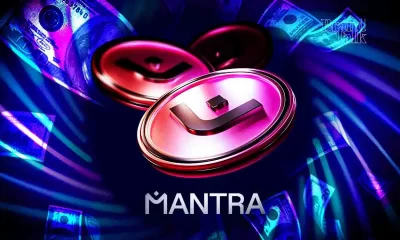Coins
There’s More to North Korea’s Hacking Ops Than Just Lazarus Group: Paradigm
Published
2 weeks agoon
By
admin

In February, North Korean hackers broke headlines with what is now regarded as the largest single hack in crypto history.
The Lazarus Group stole at least $1.4 billion from Bybit and later funneled those funds to crypto mixers.
“Someone had pulled off the biggest hack in [crypto] history, and we had a front-row seat,” Samczsun, Research Partner at Paradigm, recalled in a blog post.
The researcher said they witnessed the theft in real-time and collaborated with Bybit to confirm the unauthorized access.
Samczsun was working with SEAL 911, an emergency response unit affiliated with the Security Alliance, a nonprofit organization dedicated to securing decentralized systems.
But these attacks aren’t all just about the Lazarus Group. There’s more to North Korea’s cyber offensives than previously thought.
There’s a misconception about how to “classify and name” the group’s operations.
While the term “Lazarus Group” is “colloquially acceptable,” discussing how the DPRK (Democratic People’s Republic of Korea) runs its cyber operations on the offensive needs more rigor, Samczsun claimed.
Lazarus Group has become the preferred term by the media when describing DPRK cyberactivity. Cybersecurity researchers “created more precise designations” to show which ones are working on specific activities, they added.
A hacking bureau
The DPRK’s hacking ecosystem operates under the Reconnaissance General Bureau (RGB), which houses several distinct groups: AppleJeus, APT38, DangerousPassword, and TraderTraito
These groups operate with specific targeting methodologies and technical capabilities.
TraderTraitor, identified as the most sophisticated DPRK actor targeting the crypto industry, focuses on exchanges with large reserves and employs advanced techniques, successfully compromising Axie Infinity through fake job offers and manipulating WazirX.
AppleJeus specializes in complex supply chain attacks, including the 2023 3CX hack that potentially affected 12 million users.
Dangerous Password, meanwhile, conducts lower-end social engineering through phishing emails and malicious messaging on platforms like Telegram.
Another subgroup, APT38, spun out of Lazarus in 2016 and focused on financial crimes. It first targeted traditional banks before shifting attention to crypto platforms.
In 2018, the OFAC first mentioned “North Korean IT workers,” which in 2023 were identified by researchers as “Contagious Interview” and “Wagemole,” operating through schemes where the threat actors either pose as recruiters or attempt to get hired by target companies.
There’s still hope
While the DPRK has shown its ability to deploy zero-day attacks, there have been “no recorded or known incidents” of it deploying directly against the crypto industry, Samczsun said.
The researcher urged crypto companies to implement basic security practices such as least privilege access, two-factor authentication, and device segregation. If preventive measures fail, connecting with security groups like SEAL 911 and the FBI’s DPRK unit would also be helpful.
“DPRK hackers are an ever-growing threat against our industry, and we can’t defeat an enemy that we don’t know or understand,” Samczsun wrote.
Edited by Sebastian Sinclair
Daily Debrief Newsletter
Start every day with the top news stories right now, plus original features, a podcast, videos and more.
Source link
You may like


Crypto markets ‘relatively orderly’ despite Trump tariff chaos: NYDIG


Fartcoin ‘Hot Air Rises’ — $1.50 Just A Whiff Away


What happened to the RWA token?


Crypto Strategist Sees Solana-Based Memecoin Surging Higher, Says One AI Altcoin Flashing Strong Chart


Mantra Team Responds As The OM Token Price Crashes Over 80% In 24 Hours


This Week in Crypto Games: Gaming Tokens Crash Out, Eve Frontier Opens Up
Coins
Professor Coin: What’s Driving Cryptocurrency Adoption Around the World
Published
23 hours agoon
April 13, 2025By
admin

Professor Andrew Urquhart is Professor of Finance and Financial Technology and Head of the Department of Finance at Birmingham Business School (BBS).
This is the fifth instalment of the Professor Coin column, in which I bring important insights from published academic literature on cryptocurrencies to the Decrypt readership. In this article, we’ll investigate cryptocurrency adoption.
Cryptocurrencies are clearly growing in terms of size, scale and types of offerings, which altogether indicates the growing importance and influence they have on the traditional financial system.
They may have begun life being traded by only a select few computer programmers, but since the introduction of Bitcoin futures in 2017 and the subsequent introduction of other derivative products, culminating in the Bitcoin spot ETF launch in January 2024, more investors are taking notice of this innovative asset class.
At the core of the fourth industrial revolution is artificial intelligence, information communication and technology, the internet of things and blockchains—and PwC predicts that blockchains will boost global GDP by $1.76 trillion by 2030.
China places blockchain as one of its top five priorities, while other countries, including Germany, Japan, the UK and France, all see the potential benefits of over $50 billion. The increased investor interest in recent times may have changed the user base forever, and this adoption may differ across industries, territories, regulatory domains and political realms. In this column, I investigate what is driving cryptocurrency adoption across the globe.
Some recent work examines the relationship between certain macro-national developmental indicators and cryptocurrency deployment across 137 countries, and interestingly finds that the countries with higher education, human development, democracy, regulatory quality and gross domestic product (GDP) have higher adoption of cryptocurrencies.
However, countries with less economic freedom and more corruption have experienced less adoption, indicating that more open and free nation states have experienced adoption. This suggests that it isn’t corrupt, uneducated states that are adopting cryptocurrencies, but more open, democratic and free states.
Trust, but verify
Now that we know the economic and state variables affect adoption across different territories, but what about trust? Trust is a social construct and a belief, which fosters economic growth, financial development and financial inclusion.
Trust has fallen in recent decades—and as European Central Bank President Christine Lagarde remarked, “In this age of diminished trust, it is the financial sector that takes last place in opinion surveys.”
Work by Jalan et al (2023) supports the work by Bhimani et al (2022) in showing that countries with higher trust levels have a higher interest in, and adoption of, cryptocurrencies, confirming the importance of trust in the growth of financial markets.
In a more detailed study, Saeedi and Al-Fattal (2025) explore which aspects of trust are important for cryptocurrency adoption and they find that females place more weight on regulation trust than males, while social trust is more important for older participants.
DeFi adoption
What about the distinction between the adoption of cryptocurrencies and decentralized finance (DeFi)? Recent work by Nguyen and Nguyen (2024) suggests that high cryptocurrency adoption can arise from the combination of high population, high inflation, low social connectedness, democracy, and uncertainty avoidance, while high human development, high population, and high financial development seems to be the dominant configurations in explaining a country’s DeFi adoption.
But what impact does adoption, and different types of adoption, have on cryptocurrencies? Recent work by Rzayev et al (2025) document that early adopters of cryptocurrencies drive cryptocurrency returns and improve price efficiency, while late adopters contribute to noisier prices and efficiencies. Therefore, early adopters are key drivers for any cryptocurrencies.
Therefore, the academic literature suggests that adoption of cryptocurrencies varies widely across the world, but there are key economic and state indicators that explain adoption. Further, the type of adoption affects the performance of cryptocurrencies, indicating that not all attention is created equally.
For more information, see:
Bhimani, A., Hausken, K., Arif, S. (2022). Do national development factors affect cryptocurrency adoption? Technological Forecasting and Social Change, 181, 121739.
Jalan, A., Matkovskyy, R., Urquhart, A., Yarovaya, L. (2023). The role of interpersonal trust in cryptocurrency adoption. Journal of International Financial Markets, Institutions and Money, 83, 101715.
Nguyen, L. T. M., Nguyen, P. T. (2024). Determinants of cryptocurrency and decentralized finance adoption – A configurational exploration. Technological Forecasting and Social Chance, 201, 123244.
Rzayev, K., Sakkas, A., Urquhart, A. (2025). An adoption model of cryptocurrencies. European Journal of Operational Research, 323, 253-266.
Saeedi, A., Al-Fattal, A. (2025). Examining trust in cryptocurrency investment: Insights form the structural equation modelling. Technological Forecasting and Social Change, 210, 123882.
Daily Debrief Newsletter
Start every day with the top news stories right now, plus original features, a podcast, videos and more.
Source link
Coins
Quarter of All Bitcoin Investors Underwater as BTC Price Lags: CrypoQuant
Published
5 days agoon
April 9, 2025By
admin

Amid recent Bitcoin losses and volatility, more than a quarter—26%—of the Bitcoin supply is now “underwater,” meaning it is worth less than what it was purchased for.
This marks a stark reversal of fortunes for investors in recent months, according to data collected by market analysis tool CryptoQuant. On December 15, only 0.015% of the BTC supply was “underwater,” meaning only a very slim percentage of BTC held was without an unrealized gain for investors. As recently as January 18, the percentage of Bitcoin being held at a loss sat at just 1.46%.
But according to CryptoQuant’s data, this percentage has been slowly rising since Jan. 18, as macroeconomic concerns have impacted the prices of crypto assets. The Bitcoin price is currently sitting at $76,880.56 after having fallen 3.7% in the past 24 hours, while Ethereum is down 8.1% over the last 24 hours according to CoinGecko data, as U.S. President Donald Trump’s tariffs on Chinese goods came into play on Tuesday at midnight.
The last time such a significant proportion of the Bitcoin supply was in the red was September 6 last year, when the number hit just shy of 30%. Though at the time of writing Bitcoin is trading significantly higher than it was on September 6, when it traded at roughly $56,000, the number of “underwater” Bitcoin remains roughly comparable.
This could reflect the near-record level of inflows into BTC in late 2024 and early 2025, amid the crypto bull run accompanying the election of President Donald Trump, at historically high prices.
Though the number of Bitcoin “underwater” has appeared to broadly correlate with the BTC price over the past few years, it also reflects when speculators or investors choose to enter the market, and the price which they paid.
Institutional investors aren’t exactly piling in at current prices; $326.3 flowed out of Bitcoin ETFs yesterday, and flows have been negative for seven out of the past eight days, as per data from Farside Investors.
Investors have had it worse before
Though a big chunk of BTC investors are now in the red compared to just a few months ago, they are still faring comparatively well relative to some of the crypto world’s darkest hours.
In November 2022, around the time of the collapse of crypto exchange FTX , more than 56% of BTC investors were in the red.
Edited by Stacy Elliott.
Daily Debrief Newsletter
Start every day with the top news stories right now, plus original features, a podcast, videos and more.
Source link
Coins
93% of WazirX Creditors Greenlight Post-Hack Recovery Plan
Published
6 days agoon
April 8, 2025By
admin

After nearly being brought to its knees by a $235 million hack, WazirX just secured a vital shot at survival.
More than 93% of creditors have voted in favor of the Indian crypto exchange’s restructuring plan—clearing a key hurdle in efforts to recover from the devastating exploit, attributed to North Korean hackers.
Update on Scheme of Arrangement Voting
93.1% of voting creditors, representing 94.6% in value, have voted YES to the Scheme of Arrangement. This strong support marks an important milestone in the recovery process and reflects a shared belief in the proposed restructuring… pic.twitter.com/3eUBdMTknb
— WazirX: India Ka Bitcoin Exchange (@WazirXIndia) April 7, 2025
The plan, now headed for court sanction in Singapore, promises partial repayments, new protections, and a phased return to operations.
In a statement shared with Decrypt on April 7, Zettai Pte. Ltd., the Singapore-based holding company behind WazirX, revealed that 131,659 creditors voted to support the proposed Scheme of Arrangement.
That accounts for 93.1% by headcount and 94.6% by claim value among the 141,476 eligible voters.
“We are grateful for the strong vote of confidence,” said WazirX founder Nischal Shetty. “This consistent support across our entire base demonstrates shared belief in our restructuring approach and recovery plan.”
With assets frozen and trust fractured since the July attack, Zettai warned in early 2025 that without creditor approval, withdrawals could be delayed until 2030.
The newly approved plan sidesteps that cliff as users will now receive between 75% to 80% of their claims in USDT, while the rest will be covered by “recovery tokens” tied to WazirX’s profits and the launch of a new decentralized exchange (DEX).
To ensure full transparency, the vote results were verified by Joshua Taylor and Henry A. Chambers, Managing Directors at global consultancy firm Alvarez & Marsal, who served as independent assessors.
The formal vote report will be shared with all creditors, alongside anonymized results, as per the company statement.
The $235 million WazirX hack
The vote brings a degree of resolution to a crisis that began in July 2024, when hackers, later linked to North Korea’s Lazarus Group, compromised WazirX’s multi-signature wallets and made off with assets spanning over 200 tokens.
The stolen crypto included Ethereum (ETH), Shiba Inu (SHIB), and Polygon (POL, at the time MATIC), some of which was traced through formerly-sanctioned coin mixer Tornado Cash as part of a laundering effort involving 15,000 ETH.
The hack triggered a temporary halt to withdrawals and a criminal investigation by Delhi Police’s IFSO division, which arrested a man in West Bengal in November for allegedly opening a fraudulent WazirX account that enabled unauthorized access.
In February, CoinDCX CEO Sumit Gupta tweeted that WazirX’s lack of transparency around the breach had potentially endangered others.
“If WazirX and Phemex had disclosed all of their security breach details openly and transparently as Bybit did, the Safe{wallet} infra vulnerability could have been caught,” Gupta wrote, adding that, “The best way to protect the ecosystem is to learn openly.”
WazirX, meanwhile, has since shifted its crypto custody to BitGo and Zodia, introduced insurance coverage, and earmarked $12 million for legal costs and recovery.
Daily Debrief Newsletter
Start every day with the top news stories right now, plus original features, a podcast, videos and more.
Source link
Michael Saylor Teases New Bitcoin Buy After Strategy’s $7.69 Billion Q1 BTC Buying Spree

Crypto markets ‘relatively orderly’ despite Trump tariff chaos: NYDIG

Fartcoin ‘Hot Air Rises’ — $1.50 Just A Whiff Away

What happened to the RWA token?

Crypto Strategist Sees Solana-Based Memecoin Surging Higher, Says One AI Altcoin Flashing Strong Chart

Mantra Team Responds As The OM Token Price Crashes Over 80% In 24 Hours

This Week in Crypto Games: Gaming Tokens Crash Out, Eve Frontier Opens Up

Commerce Secretary Lutnick walks back tariff relief on electronics

Gold ETF Inflows Hit Three-Year High as PAXG, XAUT Outperform Wider Crypto Market

Israel’s New Study Shows 51% Of Public Is Interested In Adopting CBDC (Digital Shekel) – Is That So?

Solana Price Eyes Breakout Toward $143 As Inverse Head & Shoulders Pattern Takes Shape On 4-hour Chart

Crypto malware silently steals ETH, XRP, SOL from wallets

Binance Executives Met With US Government Officials To Discuss Easing of Regulatory Supervision: Report

Michael Saylor Hints At Another MicroStrategy Bitcoin Purchase, BTC Price To Rally?

From the Crypto Trenches to the Hill: Why Solana Is Making a Big Push in Washington

Arthur Hayes, Murad’s Prediction For Meme Coins, AI & DeFi Coins For 2025

Expert Sees Bitcoin Dipping To $50K While Bullish Signs Persist

Aptos Leverages Chainlink To Enhance Scalability and Data Access

Bitcoin Could Rally to $80,000 on the Eve of US Elections

Crypto’s Big Trump Gamble Is Risky

Institutional Investors Go All In on Crypto as 57% Plan to Boost Allocations as Bull Run Heats Up, Sygnum Survey Reveals

Sonic Now ‘Golden Standard’ of Layer-2s After Scaling Transactions to 16,000+ per Second, Says Andre Cronje

Ripple-SEC Case Ends, But These 3 Rivals Could Jump 500x

Has The Bitcoin Price Already Peaked?

A16z-backed Espresso announces mainnet launch of core product

The Future of Bitcoin: Scaling, Institutional Adoption, and Strategic Reserves with Rich Rines

3 Voting Polls Show Why Ripple’s XRP Price Could Hit $10 Soon

Xmas Altcoin Rally Insights by BNM Agent I

Blockchain groups challenge new broker reporting rule

I’m Grateful for Trump’s Embrace of Bitcoin
Trending

 24/7 Cryptocurrency News5 months ago
24/7 Cryptocurrency News5 months agoArthur Hayes, Murad’s Prediction For Meme Coins, AI & DeFi Coins For 2025

 Bitcoin3 months ago
Bitcoin3 months agoExpert Sees Bitcoin Dipping To $50K While Bullish Signs Persist

 24/7 Cryptocurrency News3 months ago
24/7 Cryptocurrency News3 months agoAptos Leverages Chainlink To Enhance Scalability and Data Access

 Bitcoin5 months ago
Bitcoin5 months agoBitcoin Could Rally to $80,000 on the Eve of US Elections

 Opinion5 months ago
Opinion5 months agoCrypto’s Big Trump Gamble Is Risky

 Bitcoin5 months ago
Bitcoin5 months agoInstitutional Investors Go All In on Crypto as 57% Plan to Boost Allocations as Bull Run Heats Up, Sygnum Survey Reveals

 Altcoins2 months ago
Altcoins2 months agoSonic Now ‘Golden Standard’ of Layer-2s After Scaling Transactions to 16,000+ per Second, Says Andre Cronje

 Price analysis5 months ago
Price analysis5 months agoRipple-SEC Case Ends, But These 3 Rivals Could Jump 500x


